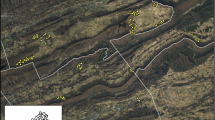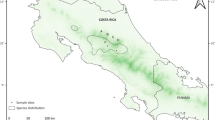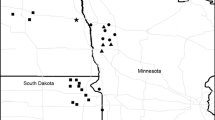Abstract
Remote sensing data can represent various habitat characteristics, and thus can substitute for detailed ground sampling when constructing habitat models. To predict saltmarsh sparrow (Ammodramus caudacutus) distribution and nesting activity, we compared Bayesian hierarchical models in which variables were generated from field or remote sensing data, at a scale of 1-ha plots and at the landscape scale. Field data consisted of plant structure and plant composition variables. Data derived from remote sensing included high and low marsh classifications, LiDAR elevation data, and a classification derived from spectral characteristics specifically associated with saltmarsh sparrow habitat use. The best sparrow presence model used a variable derived from spectral reflectance values associated with plots where sparrows did not occur, indicating that the remote sensing data included additional information about conditions associated with saltmarsh sparrow occurrence than was provided by plant composition, structure, or community classes. In contrast, nest presence was modeled best using vegetation structure variables that required data collection on the ground, although the best remote-sensing model was almost as good. These results reinforce the value of remote-sensing data in habitat modeling, and highlight the need to distinguish between sites that contribute to reproduction and sites where a species is merely present.

Similar content being viewed by others
References
Andrén H (1994) Effects of habitat fragmentation on birds and mammals in landscapes with different proportions of suitable habitat: A review. Oikos 71:355–366
Bahn V, Krohn WB, O’Connor RJ (2008) Dispersal leads to spatial autocorrelation in species distributions: A simulation model. Ecol Model 213:285–292
Bayard TS, Elphick CS (2011) Planning for sea level rise: Quantifying patterns of Saltmarsh Sparrow nest flooding under current sea level conditions. Auk 128:393–403
Benoit LK, Askins RA (2002) Relationship between habitat area and the distribution of tidal marsh birds. Wilson Bulletin 114:314–323
Bertness MD, Ellison AM (1987) Determinants of pattern in a New England salt marsh plant community. Ecol Monogr 57:129–147
Bertness M, Ewanchuk PJ, Silliman BR (2002) Anthropogenic modification of New England salt marsh landscapes. Proc Natl Acad Sci 99:1395–1398
Chambers RM, Meyerson LA, Saltonstall K (1999) Expansion of Phragmites australis into tidal wetlands of North America. Aquat Bot 64:261–273
Diez JM, Pulliam HR (2007) Hierarchical analysis of species distributions and abundance across environmental gradients. Ecology 88:3144–3152
DiQuinzio DA, Paton PWC, Eddleman WR (2002) Nesting ecology of saltmarsh sharp-tailed sparrows in a tidally restricted salt marsh. Wetlands 22:179–185
Elphick CS, Bayard T, Meiman S, Hill JM, Rubega MA (2009) A comprehensive assessment of the distribution of saltmarsh sharp-tailed sparrows in Connecticut. Final report to the Long Island Sound License Plate Program, Connecticut Department of Environmental Protection. University of Connecticut, Storrs
Fahrig L (1997) Relative effects of habitat loss and fragmentation on population extinction. J Wildl Manag 61:603–610
Garrison BA, Lupo T (2002) Accuracy of bird range maps based on habitat maps and habitat relationship models. In: Scott JM, Heglund PJ, Morrison ML, Haufler JB, Raphael MG, Wall WA, Samson FB (eds) Predicting species occurrence: Issues of accuracy and scale. Island Press, Washington, DC, pp 367–375
Gedan KB, Silliman BR, Bertness MD (2009) Centuries of human-driven change in salt marsh ecosystems. Annual Review of Marine Science 1:117–141
Gilmore MS, Wilson EH, Barrett N, Civco DL, Prisloe S, Hurd JD, Chadwick C (2008) Integrating multi-temporal spectral and structural information to map wetland vegetation in a lower Connecticut River tidal marsh. Remote Sens Environ 112:4048–4060
Gjerdrum C, Elphick CS, Rubega M (2005) Nest site selection and nesting success in saltmarsh breeding sparrows: the importance of nest habitat, timing, and study site differences. Condor 107:849–862
Gjerdrum C, Sullivan-Wiley K, King E, Rubega MA, Elphick CS (2008a) Egg and chick fates during tidal flooding of saltmarsh sharp–tailed sparrow nests. Condor 110:579–584
Gjerdrum C, Elphick CS, Rubega MA (2008b) How well can we model saltmarsh sharp–tailed sparrow numbers and productivity using habitat features? Auk 125:608–617
Gottschalk TK, Huettmann F, Ehlers M (2005) Thirty years of analysing and modelling avian habitat relationships using satellite imagery data: a review. Int J Remote Sens 26:2631–2656
Gottschalk TK, Ekschmitt K, Bairlein F (2007) A GIS-based model of Serengeti grassland bird species. Ostrich 78:259–263
Greenlaw JS, Rising JD (1994) Sharp-tailed sparrow (Ammodramus caudacutus) No 112. In: Poole A, Gill F (eds) Birds of North America. The Academy of Natural Sciences, Philadelphia, and The American Ornithologist’s Union, Washington, DC
Greenberg R, Elphick C, Nordby J, Gjerdrum C, Spautz H, Shriver WG, Schmeling B, Olsen B, Marra P, Nur N, Winter M (2006) Flooding and predation: Trade-offs in the nesting ecology of tidal-marsh sparrows. Studies in Avian Biology 32:96–109
Hill CE, Gjerdrum C, Elphick CS (2010) Extreme levels of multiple mating characterize the mating system of the saltmarsh sparrow (Ammodramus caudacutus). Auk 127:300–307
Hill JM (2008) Postfledging movement behavior and habitat use of adult female saltmarsh sharp-tailed sparrows. M. S. Thesis. University of Connecticut, Storrs, Connecticut
Hoover MD (2009) Connecticut’s changing salt marshes: A remote sensing approach to sea level rise and possible salt marsh migration. M. S. Thesis. University of Connecticut, Storrs, Connecticut
Humphreys S, Elphick CS, Gjerdrum C, Rubega MA (2007) Testing the function of nest domes in Saltmarsh Sharp-tailed Sparrows. Journal of Field Ornithology 78:152–158
Hurd J (2009) 2006 Land Cover, Greater Connecticut Connecticut’s Changing Landscape Land Cover (version 2.02) Center for Land use Education And Research (CLEAR) Storrs, Connecticut, USA http://clear.uconn.edu/projects/landscape/download.asp. Accessed 06 March 2009
IUCN (2009) IUCN Red List of Threatened Species.Version 2009.2. www.iucnredlist,org. Accessed 03 November 2009
Jenkins CN, Powell RD, Bass OL Jr, Pimm SL (2003) Demonstrating the destruction of the habitat of the Cape Sable seaside sparrow (Ammodramus maritimus mirabilis). Anim Conserv 6:29–38
Johnson MD (2007) Measuring habitat quality: A review. Condor 109:489–504
Kearney MS, Stutzer D, Turpie K, Stevenson JC (2009) The effects of tidal inundation on the reflectance characteristics of coastal marsh vegetation. J Coast Res 25:1177–1186
Mack EL, Firbank LG, Bellamy PE, Hinsley SA, Veitch N (1997) The comparison of remotely sensed and ground–based habitat area data using species-area models. J Appl Ecol 34:1222–1228
McIntire EJB, Fajardo A (2009) Beyond description: the active and effective way to infer processes from spatial patterns. Ecology 90:46–56
Morris JT, Porter D, Neet M, Noble PA, Schmidt L, Lapine LA, Jensen JR (2005) Integrating LIDAR elevation data, multi-spectral imagery and neural network modelling for marsh characterization. Int J Remote Sens 26:5221–5234
Naidoo G, McKee KL, Mendelssohn IA (1992) Anatomic and metabolic responses to waterlogging in Spartina alterniflora and S patens (Poaceae). Am J Bot 79:765–770
National Oceanic and Atmospheric Administration (NOAA) Coastal Services Center and the United States Geological Survey (USGS) (2004) Coastal Connecticut 2004 color infrared orthophoto. State of Connecticut, Department of Environmental Protection. http://cteco.uconn.edu/guides/ortho_2004_coast_infrared.htm
National Oceanic and Atmospheric Administration (NOAA), National Ocean Service, Office of Response and Restoration, Hazardous Materials Response Division, and the State of Connecticut, Department of Environmental Protection (2004) Connecticut Coastal 2002 Environmental Sensitivity Index Mapping (Polygons). State of Connecticut, Department of Environmental Protection. http://www.cteco.uconn.edu/metadata/dep/document/ESI_2002_POLY_FGDC_Plus.htm. Accessed 29 March 2009
Niering WA, Warren RS (1980) Vegetation patterns and processes in New England salt marshes. BioScience 30:301–307
Pulliam HR (2002) On the relationship between niche and distribution. Ecol Lett 3:349–361
Rhodes JR, Wiegand T, McAlpine CA, Callaghan J, Lunney D, Bowen M, Possingham HP (2006) Modeling species’ distributions to improve conservation in semiurban landscapes: Koala case study. Conserv Biol 20:449–459
Roman CT, Niering WA, Warren RS (1984) Salt marsh vegetation change in response to tidal restriction. Environ Manag 8:141–150
Rotenberry JT (1981) Why measure bird habitat? In: Capen DE (ed) The use of multivariate statistics in studies of wildlife habitat. General Technical Report RM-87. USDA Forest Service, Rocky Mountain Forest and Range Experiment Station, Fort Collins, pp 29–32
Rozsa R (1995) Human impacts on tidal wetlands: History and regulations. In: Dreyer GD, Niering WA (eds) Tidal marshes of Long Island Sound: Ecology, history and restoration. Connecticut College, New London, pp 42–50
Scott JM, Davis F, Csuti B, Noss R, Butterfield B, Groves C, Anderson H, Caicco S, D’Erchia F, Edwards TC Jr, Ulliman J, Wright RG (1993) Gap analysis: A geographic approach to protection of biological diversity. Wildl Monogr 123:1–41
Seoane J, Bustamante J, Diaz-Delgado R (2004) Are existing vegetation maps adequate to predict bird distributions? Ecol Model 175:137–149
Shriver WG, Hodgman TP, Gibbs JP, Vickery PD (2004) Landscape context influences salt marsh bird diversity and area requirements in New England. Biol Conserv 119:545–553
Spiegelhalter D, Thomas A, Best N (2000) WinBUGS user manual. MRC Biostatistics Unit, Cambridge
Teal JM, Howes BL (1996) Interannual variability of a salt-marsh ecosystem. Limnol Oceanogr 41:802–809
Tiner RW Jr (1987) A field guide to coastal wetland plants of the northeastern United States. University of Massachusetts Press, Amherst
Tuxen K, Schile L, Stralberg D, Siegel S, Parker T, Vasey M, Callaway J, Kelly M (2011) Mapping changes in tidal wetland vegetation composition and pattern across a salinity gradient using high spatial resolution imagery. Wetl Ecol Manag 19:141–157
Underwood AJ, Chapman MG, Crowe TP (2004) Identifying and understanding ecological preferences for habitat or prey. J Exp Mar Biol Ecol 300:161–187
Van Horne B (1983) Density as a misleading indicator of habitat quality. J Wildl Manag 47:893–901
Van Horne B (2002) Approaches to habitat modeling. In: Scott JM, Heglund PJ, Morrison ML, Haufler JB, Raphael MG, Wall WA, Samson FB (eds) Predicting species occurrence: Issues of accuracy and scale. Island Press, Washington, DC, pp 63–72
Vickery PD, Hunter ML Jr, Wells JV (1992) Is density an indicator of breeding success? Auk 109:706–710
Warren RS, Niering WA (1993) Vegetation change on a northeast tidal marsh: interaction of sea-level rise and marsh accretion. Ecology 74:96–103
Warren RS, Fell PE, Grimsby JL, Buck EL, Rilling GC, Fertik RA (2001) Rates, patterns, and impacts of Phragmites australis expansion and effects of experimental Phragmites control on vegetation, macroinvertebrates, and fish within tidelands of the lower Connecticut River. Estuaries 24:90–107
Warren RS, Fell PE, Rozsa R, Brawley AH, Orsted AC, Olson ET, Swamy V, Niering WA (2002) Salt marsh restoration in Connecticut: 20 years of science and management. Restor Ecol 10:497–513
Wiegand K, Schmidt H, Jeltsch F, Ward D (2000) Linking a spatially-explicit model of acacias to GIS and remotely-sensed data. Folia Geobotanica 35:211–230
Wiegand T, Jeltsch F, Hanski I, Grimm V (2003) Using pattern-oriented modelling for revealing hidden information: a key for reconciling ecological theory and application. Oikos 100:209–222
Wigand C, McKinney RA, Charpentier MA, Chintala MM, Thursby GB (2003) Relationships of nitrogen loadings, residential development, and physical characteristics with plant structure in New England salt marshes. Estuaries 26:1494–1504
Acknowledgments
Funding for this project was provided through the Department of Ecology and Evolutionary Biology at the University of Connecticut, the Connecticut Department of Environmental Protection, Office of Long Island Sound Programs, and the Connecticut Sea Grant College Program. We thank K. Banick, L. Bartlett, T. Bayard, M. Borsari, J. Brubaker, C. Bunce, M. Ellis, C. Field, T. Steeves, and K. Sullivan-Wiley for their assistance collecting data on the ground, M. Hoover for use of his state-wide marsh community GIS layer, and P. Capotosto and R. Wolfe for information about tidal marsh restoration. Permission for marsh site access was granted by the Connecticut Department of Environmental Protection, multiple municipal agencies, and an extensive group of concerned private land owners and citizen-stewards associated with the local conservation groups and land trust organizations. M. Willig and the Center for Environmental Science and Engineering at the University of Connecticut provided valuable sabbatical office space for CSE.
Author information
Authors and Affiliations
Corresponding author
Electronic Supplementary Materials
Below is the link to the electronic supplementary material.
ESM 1
(PDF 141 kb)
Rights and permissions
About this article
Cite this article
Meiman, S., Civco, D., Holsinger, K. et al. Comparing Habitat Models Using Ground-Based and Remote Sensing Data: Saltmarsh Sparrow Presence Versus Nesting. Wetlands 32, 725–736 (2012). https://doi.org/10.1007/s13157-012-0306-8
Received:
Accepted:
Published:
Issue Date:
DOI: https://doi.org/10.1007/s13157-012-0306-8




